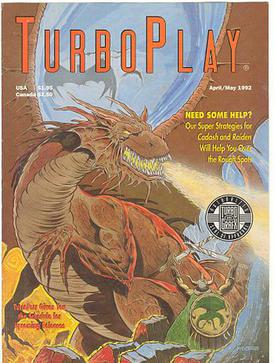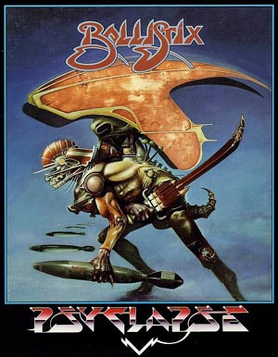
The TurboGrafx-16, known as the PC Engine outside North America, is a home video game console designed by Hudson Soft and sold by NEC Home Electronics. It was the first console marketed in the fourth generation, commonly known as the 16-bit era, though the console has an 8-bit central processing unit (CPU) coupled with a 16-bit graphics processor. It was released in Japan in 1987 and in North America in 1989. In Europe the Japanese model was unofficially imported and distributed in the United Kingdom and France from 1988. In Japan, the system was launched as a competitor to the Famicom, but the delayed United States release meant that it ended up competing with the Sega Genesis and later the Super NES.

Shadow of the Beast is a platform game developed by Reflections and published by Psygnosis in 1989. The original version was released for the Amiga, and was later ported to many other systems. The game was known for its graphics, with many colours on screen and up to twelve levels of parallax scrolling backdrops, and for its atmospheric score composed by David Whittaker that used high-quality instrument samples.

Raiden is a 1990 vertically scrolling shooter arcade video game developed by Seibu Kaihatsu and published by Tecmo in Japan. The game's story takes place in the year 2090, when an alien species known as the Crystals invaded Earth. Players assume the roles of the Vanquish Crystal Defense pilot duo, taking control of two state of the art Fighting Thunders aircraft to defeat the Crystals and save the Earth.

Stardust is a single screen multidirectional shooter video game for the Amiga, released by the Finnish company Bloodhouse in 1993. The game is an Asteroids clone with enhancements, such as power-ups, shields, a high-energy techno module soundtrack, vivid use of colors and the occasional tunnel section that revolves around a sphere. The game's graphics drew critical acclaim for the aforementioned tunnels and the liberal use of ray-tracing. The company has since merged with Terramarque to form Housemarque.
Bonk, known as PC-Genjin in Japan and as PC Kid or BC Kid in PAL territories, is a video game character and former mascot for NEC's PC Engine/TurboGrafx-16 video game console. Three platform games featuring the character appeared on the PC Engine/TurboGrafx-16, as well as two spin-offs featuring Air Zonk. The protagonist is a bald caveman named Bonk who attacks using his comically large head.

Revenge of the Mutant Camels is a horizontally scrolling shooter written by Jeff Minter for the Commodore 64 and published by Llamasoft in 1984. Enhanced versions for the Atari ST, Amiga, and IBM PC were released in 1992 as shareware.
1989 saw many sequels and prequels in video games, such as Phantasy Star II, Super Mario Land, Super Monaco GP, along with new titles such as Big Run, Bonk's Adventure, Final Fight, Golden Axe, Strider, Hard Drivin' and Teenage Mutant Ninja Turtles. The year also saw the release of the Sega Genesis and TurboGrafx-16 in North America, and the Game Boy worldwide along with Tetris and Super Mario Land.

TurboPlay Magazine is a bi-monthly, U.S.-based video game magazine which was published by L.F.P. from June/July 1990 through August/September 1992. It was available via subscription only. A total of 14 issues were released, on schedule. TurboPlay exclusively covered NEC's line of video game consoles, especially the North American models: TurboGrafx-16, TurboGrafx-CD (TG-CD), Turbo Duo (DUO) and the handheld TurboExpress. NEC's SuperGrafx also received some minor coverage.

Bonk's Adventure, known as PC Genjin in Japan and BC Kid in Europe, is a scrolling platform game developed by Red Company and Atlus and released in 1989 in Japan and 1990 in North America for the PC Engine/TurboGrafx-16. The Japanese title PC Genjin is a play on the system's original name, PC Engine, with the European title PC Kid similarly referencing the system's name. The first game in the Bonk series, it was followed by two more games for the TurboGrafx-16 before branching out to other platforms.

Valis III is a 1990 action-platform video game originally developed by Laser Soft, published by Telenet Japan and NEC for the TurboGrafx-CD. A Sega Genesis version was released in 1991. It is the third entry in the Valis series. It stars Yuko Asou, a Japanese teenage schoolgirl chosen as the Valis warrior and wielder of the mystical Valis sword after the events of Valis II. King Glames, wielder of the sword Leethus, leads denizens of the dark world to conquer both Vecanti and Earth, seeking refuge for his people amid the destruction of their planet. Together with the demon warrior-maiden Cham and her sister Valna, Yuko must prevent Glames from destroying both worlds. Through the journey, the player explores and searches for items and power-ups while fighting enemies and defeating bosses.

Ninja Spirit, known in Japan as Saigo no Nindou, is a 1988 platform game developed and released in arcades by Irem. Although praised by gamers for detailed graphics, serious themes, solid controls and gameplay, the game also was criticized for its harsh difficulty.

Best of the Best: Championship Karate is a 1992 kick boxing game that features black belt kick boxing masters. The object is to win the kick boxing championship by defeating an array of kick boxing masters in a series of fighting matches. The Sega Genesis version is one of the few games to offer support for the Sega Activator motion controller.

Bomberman, also known as Dyna Blaster in Europe, is an action-maze video game originally developed and published by Hudson Soft for the PC Engine in Japan on 7 December 1990 and later in North America for the TurboGrafx-16 by NEC in 1991. Belonging to the Bomberman franchise, it is a re-imagining of the first game in the series starring White Bomberman on a quest to rescue Lisa, the kidnapped daughter of his inventor Dr. Mitsumori, from the castle of Black Bomberman while defeating evil monsters and villains that work for him. The game was later ported to home computers, each one featuring changes compared to the original version. Conversions for other platforms were in development but never released. The title garnered positive reception from critics since its initial release on the PC Engine/TurboGrafx-16 and later on home computers.

Death Bringer, alternatively titled Galdregon's Domain in Europe, is a 1988 role-playing video game originally developed and self-published by Pandora and released for the Amiga, Atari ST, Commodore 64, TurboGrafx-CD, and Sharp X68000.

Tiger Road is a hack and slash platform game originally released in 1987 as a coin-operated arcade video game.
There have been seven video games based on The Addams Family television series and films, released between 1989 and 2022 on various home video game consoles.

Falcon is a combat flight simulator video game and the first official entry in the Falcon series of the F-16 jet fighter's simulators by Spectrum HoloByte. Originally developed by Sphere for Macintosh and MS-DOS in 1987 and ported to several platforms between 1988 and 1992, the game earned commercial success and critical acclaim.

Ballistix is a video game created by Martin Edmondson for the Amiga and Atari ST and published by Psyclapse in 1989. It was also converted to a number of other home computers in the same year and the PC Engine/TurboGrafx-16 console in 1991. It is a fictional futuristic sport involving directing a puck to a goal by shooting small balls at it.

Jack Nicklaus' Greatest 18 Holes of Major Championship Golf is a golf-simulation video game developed by Sculptured Software, and published by Accolade beginning in 1988. It was released for the Amiga, Amstrad CPC, Apple IIGS, Atari ST, Commodore 64 (C64), MS-DOS, Macintosh, MSX, Nintendo Entertainment System (NES), PC-88, Sharp X68000, and Game Boy.
The Code Monkeys Limited was a British video game developer based in Dewsbury, England, and founded in February 1988 by Colin Hogg, Mark Kirkby and Elliot Gay. It was known for porting video games to various platforms. In February 2011, shareholders of the company decided to wind down the company, which was effective two weeks later.
















